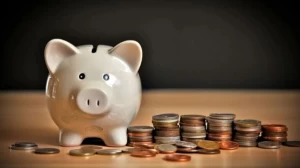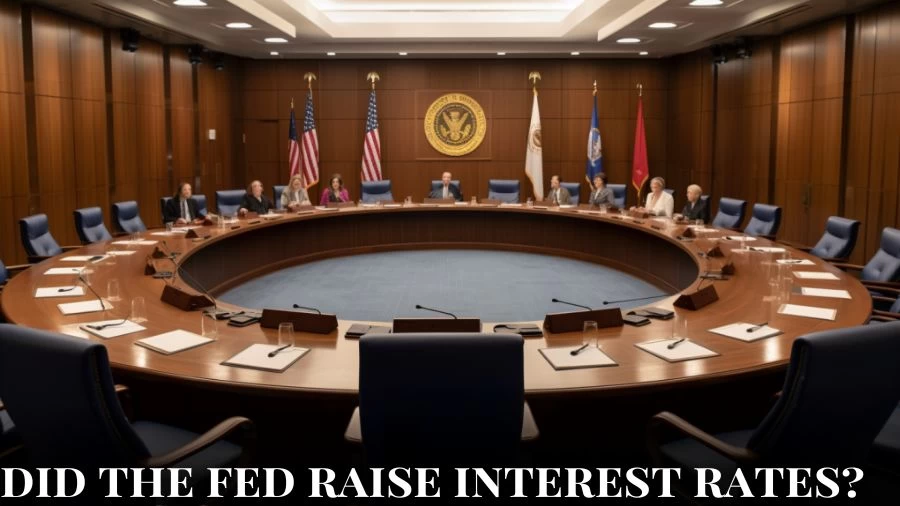
Did the Fed Raise Interest Rates? When is the Next Fed Rate Hike Expected?
Under Chair Jerome Powell's leadership, the Federal Reserve raised interest rates, with the current key rate at 5.25% to 5.5%, the highest in over two decades. The timing of the next rate increase is uncertain, requiring the Fed to balance inflation control with economic stability in upcoming meetings.
by Sangamithra
Published Sep 01, 2023 | Updated Sep 01, 2023 | 📖 8 min read
Did the Fed Raise Interest Rates?
Yes, the Federal Reserve, under the leadership of Chair Jerome Powell, has raised interest rates. Powell indicated during the Fed's annual conference, Wyoming, that the central bank could potentially raise interest rates further if the economy and job market do not weaken substantially. This decision reflects the Fed's vigilance in managing economic conditions and controlling inflation, despite some signs of cooling economic growth.
The Fed had already raised its key interest rate to a range of 5.25% to 5.5%, which is a 22-year high, and Powell emphasized their readiness to take further actions if necessary, maintaining a cautious approach to strike a balance between addressing inflation and avoiding potential harm to the economy.
When is the Next Fed Rate Hike Expected?
The timing of the next expected Federal Reserve rate hike remains uncertain, with the possibility of one more increase on the table, according to the Fed's median projection in June. However, this projection was made before a Department of Labor report showed slower job growth and a falling unemployment rate, renewing hopes for a soft landing.
With three more meetings scheduled between September and December, the Fed continues to weigh the delicate balance between combating persistent inflation and avoiding a potential recession, emphasizing the importance of monitoring key economic indicators before committing to their next move.
Fed’s Interest Rate History
The Federal Funds Rate History offers a valuable lens through which one can analyze the monetary policy choices undertaken by the Federal Reserve across the decades. This interest rate, utilized by banks for overnight loans, assumes a pivotal role in sculpting the broader economic landscape. This narrative embarks on a journey chronicling the notable junctures in the federal funds rate's history from 1990 to 2023, elucidating key occurrences and the economic backdrop in each year.
1990-1992
During this period, the Federal Reserve aggressively lowered interest rates in response to the Gulf War recession. The economy faced significant challenges, including a sharp rise in unemployment and a struggling housing market. The Fed's series of rate cuts aimed to stimulate economic growth and support recovery.
1994-1995
In these years, the Fed executed a remarkable "soft landing" by raising interest rates to curb potential inflation without causing a recession. Alan Greenspan led the FOMC to almost double the federal funds rate in just seven increases, resulting in the 1994 Bond Crash but ultimately stabilizing the economy.
1997
In 1997, with inflation inching up slightly, the Fed cautiously raised interest rates to ensure price stability. The economy was experiencing strong growth, and the Fed aimed to keep inflation anchored to its 2% target.
1998
The 1998 rate-cut cycle was unique as economic tensions stemmed mostly from global issues. Rate cuts were made to mitigate the effects of weakness in foreign economies and less accommodative financial conditions domestically, driven by crises in Asia, Russia, and the near-collapse of Long-Term Capital Management (LTCM).
1999-2000
The late 1990s saw a massive stock market boom driven by the dot-com bubble. In response, the Fed began raising interest rates to prevent inflation expectations from taking hold. Despite initial concerns, investors reacted positively to these hikes.
2001
The dot-com bubble burst in 2001, followed by the 9/11 terrorist attacks, leading the Fed to lower interest rates by a significant margin to stimulate the economy. This series of rate cuts aimed to mitigate the economic fallout.
2002-2003
In response to a flagging recovery and low inflation, the Fed executed a series of rate cuts, pushing the federal funds rate to its lowest level in 45 years. These cuts were intended to provide economic stimulus and ward off deflation.
2005-2006
After years of accommodating monetary policy, the Fed began gradually raising rates in 2005. These hikes aimed to return interest rates to more normal levels as the economy showed signs of recovery and inflation pressures increased.
2008
In the midst of the global financial crisis, the Fed responded by dramatically lowering interest rates to near-zero levels. These actions, combined with quantitative easing, were designed to stimulate the economy and stabilize financial markets during the Great Recession.
2015-2018
Following years of near-zero interest rates, the Fed embarked on a gradual tightening cycle between 2015 and 2018. The goal was to control inflation and normalize monetary policy after the Great Recession.
2019
Amid trade tensions and concerns over economic growth, the Fed initiated a series of rate cuts in 2019, referring to it as a "mid-cycle adjustment." These rate cuts were aimed at supporting the economy and mitigating potential headwinds.
2020
The COVID-19 pandemic prompted the Fed to take swift action, cutting rates to near-zero levels and implementing emergency measures. These actions aimed to counter the economic impact of the pandemic and ensure financial stability.
2022-2023
With inflation on the rise, the Fed began raising rates in 2022 to address the threat of overheating and price instability. This series of rate hikes aimed to bring inflation under control while supporting economic growth. Each of these years represents a unique chapter in the Federal Funds Rate history, reflecting the Fed's efforts to navigate various economic challenges and achieve its dual mandate of price stability and maximum employment.
Fed Interest Rates Chart
The Federal Funds Rate is a critical interest rate set by the Federal Reserve in the United States. It plays a pivotal role in influencing the broader economy by affecting borrowing costs for consumers and businesses. Understanding the historical trends of the Federal Funds Rate is essential for comprehending the Federal Reserve's response to economic conditions over the years.
Year: 2023
|
FOMC Meeting Date |
Rate Change (bps) |
Federal Funds Rate |
|
July 26, 2023 |
+25 |
5.25% to 5.50% |
|
May 3, 2023 |
+25 |
5.00% to 5.25% |
|
March 22, 2023 |
+25 |
4.75% to 5.00% |
|
Feb 1, 2023 |
+25 |
4.50% to 4.75% |
|
Dec 14, 2022 |
+50 |
4.25% to 4.50% |
|
Nov 2, 2022 |
+75 |
3.75% to 4.00% |
|
Sept 21, 2022 |
+75 |
3.00% to 3.25% |
|
July 27, 2022 |
+75 |
2.25% to 2.50% |
|
June 16, 2022 |
+75 |
1.50% to 1.75% |
|
May 5, 2022 |
+50 |
0.75% to 1.00% |
|
March 17, 2022 |
+25 |
0.25% to 0.50% |
Year: 2020
|
FOMC Meeting Date |
Rate Change (bps) |
Federal Funds Rate |
|
March 16, 2020 |
-100 |
0% to 0.25% |
|
March 3, 2020 |
-50 |
1.0% to 1.25% |
Year: 2019
|
FOMC Meeting Date |
Rate Change (bps) |
Federal Funds Rate |
|
October 31, 2019 |
-25 |
1.50% to 1.75% |
|
Sept. 19, 2019 |
-25 |
1.75% to 2.0% |
|
Aug. 1, 2019 |
-25 |
2.0% to 2.25% |
Year: 2015-2018
|
FOMC Meeting Date |
Rate Change (bps) |
Federal Funds Rate |
|
December 20, 2018 |
+25 |
2.25% to 2.50% |
|
Sept. 27, 2018 |
+25 |
2.0% to 2.25% |
|
Jun. 14, 2018 |
+25 |
1.75% to 2.0% |
Year: 2008
|
FOMC Meeting Date |
Rate Change (bps) |
Federal Funds Rate |
|
Dec. 16, 2008 |
-100 |
0% to 0.25% |
|
Oct. 29, 2008 |
-50 |
1.00% |
|
Oct. 8, 2008 |
-50 |
1.50% |
Year: 2007-2008
|
FOMC Meeting Date |
Rate Change (bps) |
Federal Funds Rate |
|
Apr. 30, 2008 |
-25 |
2.00% |
|
Mar. 18, 2008 |
-75 |
2.25% |
|
Jan. 30, 2008 |
-50 |
3.00% |
Year: 2005-2006
|
FOMC Meeting Date |
Rate Change (bps) |
Federal Funds Rate |
|
Jun. 29, 2006 |
+25 |
5.25% |
|
May. 10, 2006 |
+25 |
5.00% |
|
Mar. 28, 2006 |
+25 |
4.75% |
Year: 2000-2004
|
FOMC Meeting Date |
Rate Change (bps) |
Federal Funds Rate |
|
Jun. 30, 2004 |
+25 |
1.00% to 1.25% |
|
May. 4, 2004 |
+25 |
0.75% to 1.00% |
|
Mar. 16, 2004 |
+25 |
0.50% to 0.75% |
Year: 1997-1999
|
FOMC Meeting Date |
Rate Change (bps) |
Federal Funds Rate |
|
Jun. 30, 1999 |
+25 |
4.50% to 4.75% |
|
May. 18, 1999 |
+25 |
4.25% to 4.50% |
|
Mar. 30, 1999 |
+25 |
4.00% to 4.25% |
Year: 1995-1996
|
FOMC Meeting Date |
Rate Change (bps) |
Federal Funds Rate |
|
Dec. 19, 1995 |
+25 |
5.00% to 5.25% |
|
Nov. 15, 1995 |
+25 |
4.75% to 5.00% |
|
Sept. 26, 1995 |
+25 |
4.50% to 4.75% |
Year: 1990-1992
|
FOMC Meeting Date |
Rate Change (bps) |
Federal Funds Rate |
|
Jul. 2, 1992 |
-25 |
3.75% to 3.50% |
|
Mar. 19, 1992 |
-25 |
4.00% to 3.75% |
|
Feb. 6, 1992 |
-25 |
4.25% to 4.00% |
What is the Current Interest Rate for the Fed?
The current interest rate for the Federal Reserve, known as the Federal Funds Rate, stands at a range between 5.25% to 5.50%. This rate, determined by the Federal Open Markets Committee, plays a pivotal role in shaping U.S. monetary policy.
It influences a wide array of financial aspects, from the annual percentage yields on savings accounts to the interest rates consumers pay on credit card balances, essentially dictating the cost of money within the U.S. economy.
The Federal Funds Rate is a dynamic tool that responds to economic conditions, and it serves as a means for the central bank to manage the supply of money, contributing to its dual mandate of maintaining price stability and fostering maximum employment while ensuring the stability of the financial system.
What Was the Highest Fed Interest Rate Ever?
The highest Fed interest rate ever recorded in the United States was 20.00%. This historical peak occurred at some point between 1971 and 2023. The central bank, led by then-Fed Chair Paul Volcker, took drastic measures to rein in soaring prices by aggressively raising interest rates. The strategy aimed to reduce consumer spending and borrowing, which, in turn, would help lower inflation.
While this exceptionally high rate was effective in taming inflation, it also had significant consequences, including high borrowing costs and economic challenges. Fortunately, these measures eventually succeeded in curbing inflation, allowing interest rates to be gradually lowered.
How Much Did Fed Raise Interest Rate?
The Federal Reserve recently announced a 0.25% increase in its key interest rate, bringing it to 5.5%, the highest level seen in more than two decades. This move comes as the Fed aims to combat persistent inflation in the U.S. economy, even though consumer prices have experienced a 12-month decline, with June's year-on-year inflation rate at 3%, still above the central bank's target of around 2%.
Fed Chair Jerome Powell expressed confidence that these rate hikes would not lead to a recession, but some analysts remain cautious given the stubbornly high inflation and the need for further economic adjustments.
Did the Fed Raise Interest Rates - FAQs
1. What is the current Federal Funds Rate?
The current Federal Funds Rate ranges from 5.25% to 5.50%.
2. Why did the Federal Reserve raise interest rates recently?
The Fed raised rates to combat persistent inflation, aiming to bring it down to around 2%.
3. When was the highest Fed interest rate ever recorded?
The highest Fed interest rate was 20.00%, reached between 1971 and 2023, during efforts to curb inflation.
4. How does the Federal Funds Rate impact consumers?
It influences borrowing costs, affecting credit card and savings account interest rates.
5. Who is the current Chair of the Federal Reserve?
Jerome Powell serves as the Chair of the Federal Reserve.




